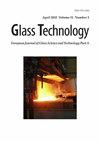玄武岩与旁通水泥粉尘制备玻璃陶瓷材料
IF 0.3
4区 材料科学
Q4 MATERIALS SCIENCE, CERAMICS
Glass Technology-European Journal of Glass Science and Technology Part a
Pub Date : 2017-02-14
DOI:10.13036/17533546.58.1.001
引用次数: 13
摘要
玻璃陶瓷是一种材料的总称,这种材料首先熔化,形成玻璃,然后以受控的方式结晶,从而产生具有意想不到性能的无孔多晶产品。受控结晶通常包括两个阶段,成核阶段和结晶阶段(1-3),其目的是产生细粒均匀的纹理,由一些无孔洞、微裂纹或孔隙的残余间隙玻璃结合的随机取向的小晶体组成。(4,5)微晶玻璃与传统玻璃或陶瓷材料相比具有显著的优势,它结合了形成的灵活性和玻璃的良好机械性能。玻璃陶瓷是一种细晶多晶材料,当适当成分的玻璃经过热处理,从而经历可控结晶,(6),它们的特点是物理和机械性能,如高抗弯强度和硬度,良好的耐腐蚀性和耐磨性。本研究使用的原料包括西奈玄武岩和旁通水泥粉尘。玄武岩是富铁玻璃和玻璃陶瓷材料的主要原料。它们主要由二氧化硅、氧化铝、氧化铁、钙、氧化镁组成,次要的是苏打、钾、二氧化钛、氧化锰和氧化磷以及微量的其他物质。(7)它们的特点是低粘度,这使得在低温下使用短生产周期就可以生产多晶材料,这就是为什么,(8)天然玄武岩的高化学耐久性意味着玄武岩和玄武岩玻璃陶瓷材料已被开发用于核废料的处理。(9)玄武岩材料具有许多重要的性质和有用的应用,因为它们可以增加瓷砖的弯曲强度,同时还可以提高材料的硬度保持所需的物理化学性能,提高烧结质量。从制作玻璃陶瓷材料的原料组合物的主要成分来看,玄武岩纤维具有导热系数低、抗氧化性高、软化和熔融温度高的特点,可作为耐热和耐火材料。(10)此外,玄武岩纤维与其他玻璃纤维相比,具有良好的抗拉强度性能。然而,玄武岩纤维复合材料在暴露于相同的热流中时,其抗拉性比同等的玻璃纤维层压板低。(11)玄武岩不仅用于道路铺设工程和作为建筑砌块的建筑材料,但它也可以在水泥制造中做出贡献,在那里它可以在不添加骨料的情况下产生更高的抗压性。(12)水泥制造业是从玄武岩和旁通水泥粉尘中制备玻璃陶瓷材料的行业之一本文章由计算机程序翻译,如有差异,请以英文原文为准。
Preparation of glass-ceramic materials from basaltic rocks and by-pass cement dust
Glass-ceramic is a generic name given to materials, which first melted, formed into glass and then crystallised in controlled manner to yield nonporous polycrystalline products of unexpected properties. Controlled crystallisation usually involves two stages, a nucleation stage and a crystallisation stage,(1–3) that aim to produce fine grained uniform textures consisting of small randomly oriented crystals bonded by some residual interstitial glass without voids, micro-cracks or porosity.(4,5) Glass-ceramics can have significant advantages over conventional glass or ceramic materials by combining the flexibility of formation and inspection of glass with good mechanical properties. Glassceramics are fine grained polycrystalline materials formed when glasses of suitable composition are heat treated and thus undergo controlled crystallisation,(6) and they are characterised by physical and mechanical properties such as high bending strength and hardness, good corrosion resistance and abrasion resistance. The raw materials used for the present investigations include basaltic rocks from Sinai and by-pass cement dust. Basalts are the main raw materials for iron-rich glass and glass-ceramic materials. They are composed of silica, alumina, iron oxide, calcia, magnesia as major oxides and, of lesser importance, soda, potassia, titania and manganese and phosphorus oxide as well as trace amounts of other species.(7) They are characterised by low viscosity, which enables production of polycrystalline materials by applying short production cycles at low temperatures, which is why, many researchers are keen on studying the melting and crystallisation behaviour of different igneous rocks and characterising the materials obtained.(8) The high chemical durability of natural basalts mean basalt as well as basaltic glass-ceramic materials have been developed for nuclear waste disposal.(9) For vitrification of various hazardous industrial wastes basaltic materials have many important properties and useful applications as they can increase the bending strength of tiles while preserving the physical-chemical properties required and improving sintering quality. Considering the main component of the raw materials compositions for making glass ceramic materials they can be used as heat and fire resistant materials because of their low thermal conductivities, high oxidation resistance, and high softening and melting temperatures.(10) In addition, basalt fibre has good tensile strength properties compared to other glass fibres. However basaltic fibre composites have a lower tensile fire resistance than an equivalent glass fibre laminates when exposed to the same heat flux.(11) Not only is basalt is used in road paving works and as a construction material for building blocks, but also it can be contributed in cement manufacturing where it results in a higher compressive resistance without the addition of aggregates.(12) The cement manufacturing industry is one of the Preparation of glass-ceramic materials from basaltic rocks and by-pass cement dust
求助全文
通过发布文献求助,成功后即可免费获取论文全文。
去求助
来源期刊
CiteScore
0.30
自引率
0.00%
发文量
0
审稿时长
>12 weeks
期刊介绍:
The Journal of the Society of Glass Technology was published between 1917 and 1959. There were four or six issues per year depending on economic circumstances of the Society and the country. Each issue contains Proceedings, Transactions, Abstracts, News and Reviews, and Advertisements, all thesesections were numbered separately. The bound volumes collected these pages into separate sections, dropping the adverts. There is a list of Council members and Officers of the Society and earlier volumes also had lists of personal and company members.
JSGT was divided into Part A Glass Technology and Part B Physics and Chemistry of Glasses in 1960.

 求助内容:
求助内容: 应助结果提醒方式:
应助结果提醒方式:


